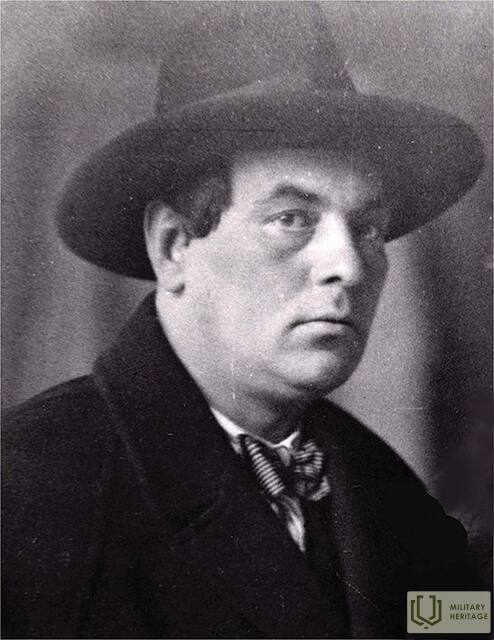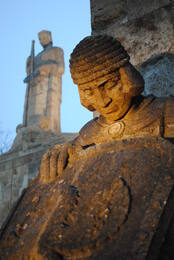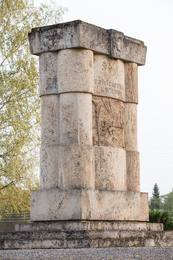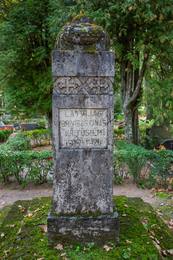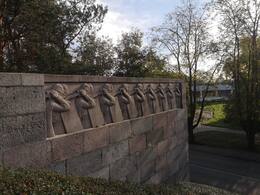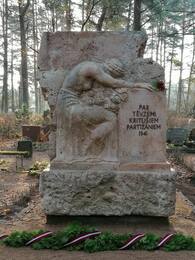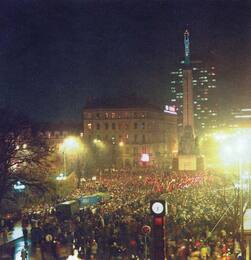Kārlis Zāle (1888-1942), skulptorius, Latvijos monumentaliosios skulptūros meistras
Kārlis Zāle (tikrasis vardas Johans Kārlis Leonhards Zālīte) gimė 1888 m. lapkričio 28 d. Mažeikiuose, Kauno gubernijoje. Mokėsi Liepojos miesto mokyklos vakariniuose piešimo, lipdymo ir tapybos kursuose, Kazanės meno mokykloje (1909–1913 m.), skulptoriaus Stepano Erzjos (С.Д.Эрзья) dirbtuvėse Maskvoje (1914–1915 m.), Petrogrado meno skatinimo draugijos imperatoriškojoje mokykloje (1916 m.), Petrogrado meno akademijos aukštojoje meno mokykloje, Petrogrado valstybinėse laisvosiose meno dirbtuvėse. Studijų tikslais jis gyveno Berlyne (1921–1923 m.) ir Italijoje (1926 m.).
Reikšmingiausi Kārlio Zāle kūriniai – Rygos brolių kapinių ir Laisvės paminklo skulptūros. Kārlis Zāle 1924–1936 metais kūrė skulptūrų grupes ir dekoratyvinius elementus Brolių kapinių ansambliui (architektai Pēteris Feders, Aleksandrs Birzenieks, sodo architektas Andrejus Zeidaks). Ansamblį sudaro 11 skulptūrų.
Laisvės paminklui Rygoje (1931–1935 m., architektas Ernestas Štālbergas) Kārlis Zāle sukūrė alegorinę Laisvės skulptūrą (vario kalimas, auksavimas), grupes, dengiančias apatinę obelisko dalį, alegorines grupes postamento kampuose, du reljefus postamento plokštumose ir du reljefus terasos išoriniuose paviršiuose.
Kārlis Zāle sukūrė skulptūrinį frizą paminklui Sudrabkalninyje, skirtam Rygos pulko kariams, gynusiems Rygą 1919 m. (1929–1937 m., architektas E. Štālbergsas), paminklą žuvusiems Latvijos laisvės kovose brolių kapinėse Jaunpiebalgoje (1930 m., architektas A. Birzenieksas), šauliams, žuvusiems Pirmajame pasauliniame kare Smārdės stotyje (1936 m.), gyventojams, žuvusiems netoli Raganos 1941 m., ir žuvusiems savigynos būrio nariams Inčukalno kapinėse (1944 m., sunaikintas, restauruotas 1988 m.). Jis taip pat yra sukūręs antkapinių paminklų individualiems asmenims.
1936–1940, taip pat 1941–1942 metais Kārlis Zāle vadovavo Dailės akademijos skulptūrų dirbtuvėms. Kārlis Zāle buvo UL studentų draugijos „Konkordia Valdemārija“ narys.
Kārlis Zāle buvo Trijų žvaigždžių ordino didysis karininkas (1935 m.), Tėvynės premijos laureatas (1938 m.) ir Latvijos meno akademijos garbės narys (1939 m.).
Kārlis Zāle mirė 1942 m. vasario 19 d. savo namuose „Atvasītē“ Inčukalno valsčiuje ir buvo palaidotas Rygos brolių kapinėse.
Daugiau informacijos šaltinių
Laila Bremša. Kārlis Zāle. Nacionalinė enciklopedija: https://enciklopedija.lv/skirklis/34800
Vaidelotis Apsītis, Laisvės paminklas. - Ryga, Zinātne, 1993 m.
Vaidelotis Apsītis, Brolių kapinės, Ryga, Mokslas.- 1995 m.
Rygos brolių kapinėse. 1915-1936-2011., sudarė Guntis Gailītis.- Ryga, Jumava, 2011 m.
Susijusi laiko juosta
Susijusios vietos
Brolių kapinės Rygoje
Rygos brolių kapinės yra šiauriniame Rygos rajone. Kapinės užima 9 ha plotą ir yra iškiliausias bei reikšmingiausias memorialinis ansamblis Latvijoje, skirtas žuvusiems Latvijos kariams. Čia palaidota apie 3000 karių. Brolių kapinės buvo įkurtos Pirmojo pasaulinio karo metu, palaidojus pirmuosius tris Latvijos šaulius, žuvusius Tyrelio purve mūšyje prieš vokiečių armiją. Vėliau Brolių kapinėse taip pat buvo palaidoti Latvijos kariai, žuvę kituose mūšiuose ir karuose. Memorialas sukurtas pagal skulptoriaus Kārlio Zālės projektą ir yra pirmasis memorialinis ansamblis Europoje, turintis tokią kraštovaizdžio, architektūros ir skulptūrinę vertę. Jame naudojami Latvijos kraštovaizdžiui būdingi elementai, tradicinės sodybos, Latvijos folkloras ir istorija, kurie giria karių savybes ir pasakoja apie kario kelią. Memorialas buvo atidengtas 1936 m. ir jį sudaro trys dalys: „Minties kelias“ – 250 m ilgio alėja, „Didvyrių terasa“ su Šventosios liepsnos aukuru ir Šventosios ąžuolyno ansambliu bei laidojimo vieta su Latvijos siena ir motinos su žuvusiais sūnumis memorialu.
Paminklas Nepriklausomybės kare žuvusiems kariams
Įsikūręs netoli Jaunpiebalgos Šv. Tomo evangelikų liuteronų bažnyčios.
Matomas skulptoriaus Kārlio Zāleso ir architekto Aleksandro Birzeniekas sukurtas paminklas Jaunpiebalgos parapijos nariams, žuvusiems Nepriklausomybės kare.
Paminklas atidengtas 1930 m. birželio 29 d. Jį suprojektavo skulptorius Kārlis Zāle ir architektas Aleksandras Birzenieks, tačiau kalimo darbai atlikti E. Kuraus akmentašių dirbtuvėse Rygoje. Paminklas suprojektuotas kaip architektūrinė arka. Dvi kolonos su masyvia sąrama išdėstytos trijų pakopų terasoje. Tarp kolonų yra figūrinis reljefas – Motina laimina du sužeistus sūnus.
Remiantis Jaunpiebalgos vidurinės mokyklos mokytojos Vēsmos Johansonės J. Lismaniui pateikta informacija, prie paminklo pamatų buvo padėta urna su 125 žuvusių parapijiečių sąrašu. Tačiau to meto spauda mini tik 60 žuvusiųjų. Tą pačią dieną aplink bažnyčią buvo pasodinta „Didvyrių giraitė“ – 60 ąžuolų.
Jaunpiebalgos evangelikų liuteronų Šv. Tomo bažnyčia buvo pašventinta 1804 m. liepos 4 d., tačiau nuo 1871 iki 1873 m. bažnyčia buvo perstatyta pagal Matthias von Holst projektą. Joje yra 800 sėdimų vietų, o altorius ir sakykla išdrožti iš ąžuolo. Kai Jaunpiebalgos bažnyčia šventė 200 metų jubiliejų, bažnyčia buvo pavadinta Šv. Tomo vardu.
Jaunpiebalgos bažnyčia, nacionalinės svarbos kultūros paminklas ir didžiausia liuteronų bažnyčia už Rygos ribų, suvaidino svarbų vaidmenį formuojant daugelio iškilių kūrybingų asmenybių dvasinį pasaulį.
Karinio paveldo paminklai Dīvalinios kapinėse Valmieroje
Įsikūręs Valmieros Dīvalas (Jānis) kapinėse Valmieroje.
Matomas skulptorės Martos Lange sukurtas ir 1937 m. rugsėjo 26 d. atidengtas iš Allažio travertino pagamintas paminklas.
Stulpo formos paminklą vainikuoja nuožulnus altorius, ant kurio stovi ąžuolo lapų vainikas ir iš travertino išdrožtas šalmas.
Palaidota apie 80 karių, žuvusių Latvijos Nepriklausomybės kare, taip pat tų, kurie mirė nuo sužalojimų ir ligų.
Netoliese yra vienas iš mažiau žinomų Kārlio Zāleso darbų – paminklas „Nukritusios rožės“, siejamas su Brolių kapinių ansamblio sukūrimu.
Netoliese yra ir komunistinio teroro aukų memorialas – akmuo su užrašu: „1941 m. komunistinio režimo nužudytiesiems“ ir balti kryžiai.
Sudrabkalninio kalnas – memorialas kovai su Bermonto armija
Įsikūręs Rygoje, Pārdaugavoje, Sloko ir Kurzemes prospektų sankirtoje.
1919 m. lapkričio pradžioje, per Latvijos nepriklausomybės karus, Pardaugavoje vyko gatvių mūšiai tarp Latvijos armijos ir Bermonto kariuomenės. Lemiamas puolimas prieš Bermonto armiją įvyko šioje vietovėje. 1937 m. Sudrabkalninyje pagal Kārlio Zālės projektą buvo atidengtas paminklas, pagerbiantis žuvusius 6-ojo Rygos pėstininkų pulko karius ir pabrėžiantis jų karines savybes.
Sukurta kaip memorialinė siena – simbolinis įtvirtinimas, kurio vartuose pavaizduotas liūtas, blokuojantis kelią priešo puolimui. Pastatyta iš Daugavgryvos tvirtovės gynybinio pylimo akmeninių blokų ir iškalta iš Laisvės paminklo likusio granito. Memorialinės vietos kaina siekė beveik 35 000 latų. Palyginimui, už šią sumą buvo galima įsigyti 4 Latvijoje pagamintus „Ford - Shield V8 De Luxe“ automobilius.
Šiandien galite aplankyti vieną įspūdingiausių Nepriklausomybės kovų memorialų.
Paminklas „Sėdinčiai motinai“ Inčukalno garbės kapinėse
Yra: Inčukalno savivaldybė, Inčukalns, Miera gatvė, Inčukalno kapinės.
Paminklas atidengtas: 1944 m. liepos 16 d. Paminklas atidengtas po K. Zālės mirties. Užrašas: Žuvusiems Tėvynės partizanams 1941 m. (atkurtas). Paminklas restauruotas 2020 m. lapkričio 5 d. Paminklas restauruotas remiant Inčukalno regioninei tarybai. Restauratorius menininkas Igoris Dobičinas.
Įvykiai: „1940 m. birželio 17 d. Latviją okupavo SSRS. 1941 m. birželio 14 d. buvo vykdomos trėmimai. 1941 m. birželio 22 d. Vokietija užpuolė SSRS, ir Vermachto daliniai įžengė į Latviją. Raudonoji armija ir jos rėmėjai atsitraukė. Daugelyje Latvijos vietų – įskaitant Raganą, Sėją ir Inčukalną – buvę sargybiniai ir patriotiškai nusiteikęs jaunimas organizavosi ginti savo namų ir skubėti išvyti sovietų okupantus. Kai 1941 m. liepos 1 d. Sėjos valsčiaus „Ziediņi“ (Gėlės) rajone vėl buvo iškelta Latvijos Laisvosios Valstybės vėliava, specialieji Raudonosios armijos daliniai Šiaurinėse kapinėse sušaudė šio namo savininkę – 39 metų Elzą Višą, o Sėjos ir Krimuldos valsčių pasienyje – jos motiną – 64 metų Elzą Martinovą. Tai sukėlė dar daugiau neapykantos ir pasipiktinimo tarp vietovės gyventojų, ir jie pradėjo...“ susiburti į liaudies pasipriešinimo judėjimą ir kurti savigynos būrius, kurie dar buvo vadinami pirmaisiais partizanais (Inčukalno grupės vadas buvo Maksis Cālītis). Prie regiono kovotojų prisijungė ir iš Litenės karinės stovyklos pabėgę arba paleisti vadinamojo Latvijos teritorinio korpuso kareiviai bei karininkai. Po kelių dienų, liepos 4 d., įvyko ginkluotas susidūrimas su raudonaisiais, mūšyje žuvo septyni kareiviai ir Raganos vaistininko sūnus Pēteris Prašķēvičs. Be to, Raganos mūšyje buvo sužeistas ir paimtas į nelaisvę 17 metų Rėzeknės mokytojų instituto studentas Jānis Porietis, kuris buvo kankinamas, sušaudytas ir palaidotas netoli Straupės.
Čia, Inčukalnyje, buvo iškastas bendras brolių kapas, į kurį aštuoniais arklių traukiamais vežimais po vieną buvo vežami iš baltų neobliuotų lentų pagaminti karstai, kad žuvę didvyriai galėtų ilsėtis gimtojoje žemėje. Po kelių mėnesių, jau vokiečių okupacijos metu, kapinėse buvo įrengtas Kārlio Zāleso (nuo 1939 m. iki gyvenimo pabaigos 1942 m. vasario 19 d., dėl sunkios ligos genialusis latvių skulptorius pasirinko Inčukalną savo gyvenamąja vieta) suprojektuotas paminklas – sielvartaujančios motinos ant rožių kelių atvaizdas. 1950-aisiais vietos komunistų aktyvistai paminklą susprogdino. Paminklas apgadintas ir nejudantis gulėjo iki pat Atgimimo, kai 1980-ųjų pabaigoje vis daugiau žmonių susidomėjo ir kalbėjo apie 1941 m. liepos 4 d. įvykius bei ragino restauruoti Kārlio Zāleso paminklą. Šis reikalavimas buvo išsakytas 1988 m. rugsėjo 8 d. Inčukalno pradinėje mokykloje sušauktame žmonių ir valdžios susirinkime, kuriame dalyvavo ne tik Inčukalno gyventojai, bet ir netoliese esančių parapijų gyventojai, taip pat Aplinkos apsaugos klubo ir Latvijos nacionalinės komunistų sąjungos nariai iš Rygos.
... Paminklo restauravimo darbuose aktyviai dalyvavo Inčukalno gyventojai – Teodors Ildens, Arvīds Blaus, Pēteris Vorfolomējevs, ... ir daugelis kitų patriotiškai nusiteikusių žmonių. 1989 m. liepos 4 d. naujai atgimęs kilnus ir liūdnas paminklas buvo iškilmingai pašventintas kunigo Vairos Bitēnas.“
Lāčplėsio karinio ordino generolų ir riterių atminimo vietos Trikātos valsčiuje
Atminimo stela yra šalia Trikatos kapinių koplyčios.
Trikātos kapinėse saugomas trijų iškilių Latvijos generolų – Roberto Dambīčio, Kārlio Gopperso ir Jānio Balodžio – atminimas. Trikātos kapinėse palaidotas ir visų šių generolų mokytojas Jēkabs Mūrnieks, kuriam 1928 metais palaidojimo vietoje buvo pastatytas paminklas iš travertino, sukurtas pagal Kārlio Zāle pavyzdį.
Lačplėsio karinio ordino generolai ir riteriai kasmet pagerbiami fakelų procesijomis į Trikatos kapines, kur yra dvi atminimo stelos, kuriose iškalti 17 su Trikatos parapija susijusių Lačplėsio karinio ordino riterių vardai.
Stela buvo atidengta 2018 m. lapkričio 11 d.
Vaizdo įrašas apie Lāčplės karo ordiną ir ordinų rinkinį , priklausiusį generolui Jāniui Balodiui.
Laisvės paminklas Rygoje
Laisvės paminklas buvo vienas iš centrinių simbolinių Atgimimo įvykių taškų. 1987 m. birželio 14 d. žmogaus teisių grupė „Helsinki-86“ surengė nesankcionuotą viešą gėlių padėjimo ceremoniją prie Laisvės paminklo. Po dviejų mėnesių, rugpjūčio 23 d., „Helsinki-86“ paragino surengti mitingą prie Laisvės paminklo, minint 48-ąsias Hitlerio ir Stalino pakto, pasirašyto 1939 m. rugpjūčio 23 d., metines. Šio mitingo metu sovietų policija sumušė ir suėmė demonstrantus. Vėlesniais metais gėlių padėjimo ceremonijos prie Laisvės paminklo tapo visų didesnių demonstracijų ir kitų masinių renginių dalimi.
Įsikūręs Rygos centre, Laisvės aikštėje.
Laisvės paminklas yra vienas iškiliausių Latvijos istorijos, architektūros ir meno paminklų. Pastatytas pagal Kārlio Zālės projektą visuomenės aukomis. Jis buvo atidengtas 1935 m. kaip Latvijos žmonių laisvės ir meilės tėvynei simbolis. Kartu su Rygos brolių kapinių ansambliu jis yra vienas vertingiausių monumentaliosios architektūros ir skulptūros pavyzdžių.
Laisvės paminklas išreiškia Latvijos kultūros etines ir estetines vertybes. Simboliai atspindi filosofinę laisvės esmę ir Latvijos tautos istorines idėjas apie kovos už nepriklausomybę etapus. Jie nurodo į fizinės ir dvasinės stiprybės įsikūnijimą. Herojiška kalba pasakoja apie Latvijos žmones kaip savarankiškus, aktyvius istorijos kūrėjus ir savo likimo lėmėjus.
Jo vietoje iš pradžių stovėjo paminklas Rusijos carui Petrui I. Pirmojo pasaulinio karo metu jis buvo išardytas ir laivu nugabentas į Petrogradą. Laivą torpedavo vokiečių povandeninis laivas, ir jis nuskendo prie Estijos Vormsi salos. Sovietų okupacinis režimas kelis kartus planavo nugriauti Laisvės paminklą, tačiau to neįvyko.
Šiandien galite pamatyti vieną iš Latvijos simbolių ir stebėti kariuomenės garbės sargybos tradicijas.
Ant kanalo kranto, šalia Laisvės paminklo, sukurtas taktilinis Laisvės paminklas. Šią ypatingą bronzinę miniatiūrą 1:50 masteliu sukūrė skulptorius Ivaras Miķelsonsas.
Susijusi istorija
Oskaro Kalpako atminimui
Oskaro Kalpako atminimas saugomas daugelyje vietų – tai liudija jo gimtieji Liepsalu namai, paminklas Visagalos kapinėse, minėjimo renginiai ir gražūs koncertai kovo 6 d., Meirānu Kalpako pradinė mokykla, gatvės Lubanoje, Madonoje ir kituose miestuose ir taip toliau. Tačiau šiame straipsnyje – apie Oskaro Kalpako atminimo išsaugojimą gimtajame krašte XX a. 3–4 dešimtmečiais.




